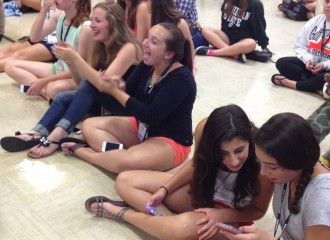-

Grosse Pointe South’s The Tower’s editor-in-chief Megan Fleming and the staff cheer on an act at the MIPA Variety Show. - On the first day of camp, the first observation is the overwhelming amount of people. The huge mass is split up into various schools. Some staffs send under five kids, other staffs send more than 20 kids. The 395 students are made up of editors in chief to beginning journalism students. Their ideas of what to bring back to their adviser and share with their fellow staff members differs, but they are all here for the purpose of bettering their school’s publication.
Grosse Pointe South is made up of 25 student journalists. Within the staff, students split up in various classes depending on their role on staff next year. For example, page editors are taking InDesign classes, while the leadership team is taking Taking Your Newspaper to the Edge.
They hope to apply the concepts of their classes during the redesign of the paper, an annual occurrence for South to tweak different pages.
“I think this year, it’s going to be about engaging the students really, writing things that are not only interesting to the community but to really find things that make kids want to read the paper more,” editor-in-chief Megan Fleming said.
Although South adviser and MIPA instructor Jeff Nardone wasn’t expecting such a large number at first, he looked forward to bringing more kids.
“I always like that students want to come to a class, like this or an opportunity like this,” Nardone said. “I always say ‘I’m a teacher, I’ve got great ideas, the students like me and respect me, but there are some great teachers from around the country here that can give them great opportunities to learn.’”
The reason for a growing number of South students going to MIPA is because of an increasing number of journalism students back at the school.
“For the first 10 years I advised, I had one section, 30 kids, that was it. Now I have three sections with about 85 kids. One section does the website, and two sections do the newspaper,” Nardone continued.
To be able to bounce ideas off each other, the campers sit with each other at mealtimes, and occasionally meet with Nardone for a dinner off-campus.
“We check in with him, he checks in with us,” Fleming said.
Compared to smaller staff sizes at the camp, administrators such as Chad Sanders have noticed communication differences, especially when returning home to the rest of the students.
“When you’re here with your whole staff, you don’t have to make that sales pitch (to the non-camp students). Everybody’s here, everybody knows what’s awesome, everybody’s ready to go,” Sanders explained.
You can see the small staff point of view here.

[…] You can see the large staff’s point of view here. […]